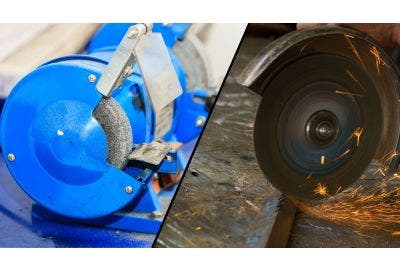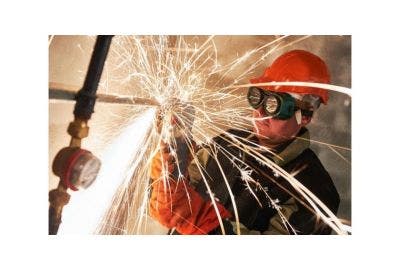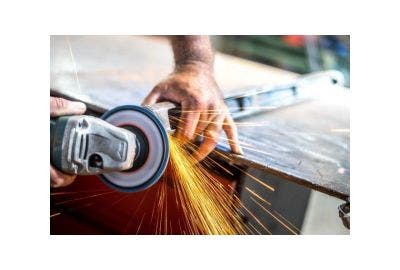In professional trades and industrial settings, the choice of tools can significantly impact the efficiency, precision, and quality of work. Among the many power tools available, angle grinders and bench grinders stand out for their versatility and reliability in various applications. Selecting the right grinder not only improves productivity but also ensures the safety and longevity of other equipment.
This article explores the distinct features, uses, and advantages of angle grinders and bench grinders, helping you identify which tool best suits your specific needs. By understanding the strengths and limitations of each, you can make a confident decision tailored to your professional requirements.
What is an Angle Grinder?

An angle grinder is a portable power tool designed for a wide range of tasks, including cutting, grinding and polishing. Its compact design features a rotating disc driven by a powerful motor, combined with a handle for improved control and manoeuvrability. This makes angle grinders a favourite for professionals who require flexibility in their workspace.
In professional environments such as metalworking, automotive repair and fabrication, angle grinders excel in tasks that demand mobility and adaptability. The tool’s versatility is amplified by the variety of discs available, each tailored to specific tasks. For instance, grinding discs are used for smoothing surfaces, cutting discs for slicing through metal or stone, and wire brushes for rust removal.
Its lightweight, handheld nature enables an angle grinder to operate effectively in confined spaces, making it invaluable for jobs requiring precision and portability. With the right disc, professionals can achieve optimal results, enhancing both efficiency and quality in their work.
What is a Bench Grinder?

A bench grinder is a stationary power tool designed for tasks that require precision and stability. It typically comprises a motor, grinding wheels, and a sturdy base, offering a secure platform for detailed and controlled work. Unlike handheld tools, the fixed nature of a bench grinder makes it ideal for workshops and professional environments where consistency is paramount.
Bench grinders are commonly used for sharpening tools, deburring metal parts, and smoothing rough surfaces. The grinding wheels, available in various types and sizes, can be selected based on the task at hand. For example, coarse wheels are perfect for heavy-duty grinding, while fine-grit wheels excel in polishing and precision work.
Industries such as metalworking, construction, and automotive repair value bench grinders for their durability and reliability. By providing a stable working platform, they ensure accurate results, making them indispensable for tasks requiring meticulous attention to detail.
Purpose

When deciding between an angle grinder and a bench grinder, it’s essential to understand their distinct purposes. Each tool is uniquely suited to specific tasks based on its design and functionality, making the choice dependent on your professional needs.
Angle grinders are ideal for jobs requiring mobility and versatility. Their lightweight, portable design allows professionals to take the tool directly to the workpiece, which is particularly useful for tasks such as cutting metal pipes, grinding welds or polishing large surfaces. For example, in a construction setting, an angle grinder might be used to prepare steel reinforcements or smooth down concrete edges.
In contrast, bench grinders are built for stability and precision. Their stationary nature makes them perfect for tasks that demand a steady platform, such as sharpening chisels, deburring small parts, or smoothing intricate details on metal components. Workshops and garages often rely on bench grinders for tool maintenance, ensuring equipment stays sharp and functional over time.
By understanding the unique strengths of these grinders, professionals can select the tool that aligns with the requirements of their specific tasks. While angle grinders offer unmatched flexibility, bench grinders provide the accuracy needed for detailed work, making both indispensable in their respective roles.
Material Removal Rate

The material removal rate is an important consideration when selecting a grinding tool. It determines how efficiently material can be removed, which is particularly relevant in professional applications where both speed and precision are valued.
Angle grinders typically offer a higher material removal rate, thanks to their fast-rotating discs and powerful cutting action. This makes them well-suited to tasks such as cutting thick metal, grinding welds or shaping concrete. For example, a fabrication specialist using an angle grinder with a coarse grinding disc can efficiently tackle large-scale projects requiring quick material removal.
Bench grinders, on the other hand, provide a slower, more controlled removal rate. This precision is essential for activities like sharpening tools or refining small components. The type of grinding wheel used plays a key role in this process—coarse wheels are designed for quicker removal, while fine-grit wheels are ideal for delicate finishing tasks.
When choosing between these tools, professionals should assess whether their work prioritises speed or accuracy. For high-intensity jobs requiring rapid progress, the angle grinder is often preferred. Conversely, the bench grinder is better suited to tasks requiring detailed, precision-driven results.
Ease of Use

The ease of use for both angle grinders and bench grinders depends on factors such as mobility, setup, and the level of skill required to operate them effectively.
Angle grinders are highly valued for their portability and flexibility. Their lightweight design makes them easy to manoeuvre, even in tight or awkward spaces. However, using an angle grinder requires a steady hand and a good understanding of the task at hand, especially for detailed work. Professionals can enhance their efficiency by choosing the right disc for the job and maintaining a firm grip on the tool during operation.
Bench grinders, being stationary tools, offer stability and precision, which simplifies tasks like sharpening or deburring. Once set up, a bench grinder provides a reliable platform for consistent results. Its straightforward operation requires less physical effort compared to handheld tools, making it easier to use for extended periods. To improve ease of use, professionals should ensure the grinding wheels are properly aligned and routinely maintained.
Both tools come with their own learning curves, but with the right techniques and maintenance, they can perform efficiently and safely in any professional setting.
Safety

Safety is paramount when using power tools like angle grinders and bench grinders. Both tools present specific risks, and adhering to best practices is essential to maintain a secure working environment.
The high-speed operation of angle grinders makes them effective but also increases the risk of kickback and accidental slips. To reduce these hazards, always use the correct disc for the material, maintain a firm grip and avoid applying excessive pressure. Wearing appropriate personal protective equipment (PPE), such as safety goggles, gloves and hearing protection is essential. Additionally, ensure the workspace is free from obstacles that could hinder movement or lead to accidents.
Bench grinders require attention to prevent wheel-related incidents, such as shattering or excessive wear. Before use, inspect the grinding wheels for cracks or damage and replace them as needed. The tool’s stationary design reduces the risk of slips, but care must still be taken to avoid entanglement, especially when working with loose clothing or long hair. Safety shields and spark guards should always be in place, and keeping the tool well-maintained ensures safer operation.
By following these guidelines and keeping tools in optimal condition, professionals can minimise risks and maintain a safer work environment.
Applications

The applications of angle grinders and bench grinders vary widely, with each tool excelling in specific tasks across different industries.
Angle grinders are celebrated for their versatility, making them indispensable in industries like construction, metalworking and automotive repair. Common uses include cutting metal pipes, grinding down welds and polishing large surfaces. In construction, they are often used to prepare materials such as steel or stone for installation, while in metalworking, they are ideal for removing rust or smoothing edges. Their portability allows them to perform effectively in diverse locations, making them a go-to choice for mobile tasks.
Bench grinders are best suited for precision-focused tasks in controlled environments. They are frequently used in workshops for sharpening tools like chisels, drill bits, and blades, ensuring that equipment stays in top condition. These grinders are also invaluable for deburring small metal parts and refining intricate details. In automotive repair, for example, a bench grinder might be employed to polish components or smooth edges after fabrication. Their fixed nature provides stability, making them ideal for tasks requiring a steady hand and consistent pressure.
When selecting a grinder, consider the specific requirements of your tasks. Angle grinders are perfect for flexible, on-site work, while bench grinders excel in detailed, stationary applications. Both tools can greatly enhance efficiency and precision when matched to the appropriate job.
Choosing the right grinder is essential for achieving efficiency, precision, and safety in professional settings. Angle grinders offer unmatched mobility and versatility, making them ideal for tasks requiring rapid material removal and adaptability. On the other hand, bench grinders provide stability and precision, excelling in detailed, stationary applications such as tool sharpening and metal finishing.
By carefully evaluating the specific requirements of your projects, you can select the grinder that best suits your professional needs. Whether you need the flexibility of an angle grinder or the reliability of a bench grinder, the right tool can significantly enhance your productivity.
For more guidance on grinding tools and to explore a wide range of professional-grade equipment, you can contact us for further expert advice.






















